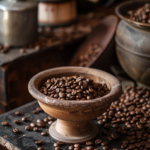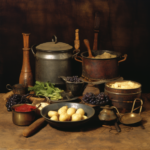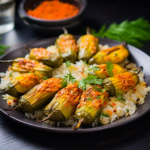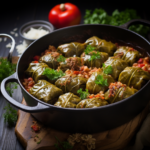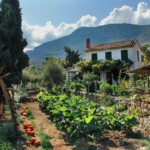
Greek Orthodox Easter is not only a profoundly sacred period in Greece but also a time when culinary traditions take center stage. The celebration of Easter in Greece is marked by unique Greek cooking techniques that have been passed down through generations. These methods and practices are deeply intertwined with the religious and cultural observances of the season, creating a vibrant tapestry of flavors and aromas that highlight the joy of this pivotal time of year.
1. Tsoureki Baking
Tsoureki, the traditional Greek Easter bread, is a highlight of holiday cooking. This sweet, brioche-like bread is characterized by its braided form and the subtle flavors of mahlab (a spice made from cherry pits) and mastic (a resin from the mastic tree of Chios). The dough is carefully kneaded and allowed to rise multiple times to achieve its characteristic soft, fluffy texture. A red-dyed hard-boiled egg is often nestled into the braids before baking, symbolizing the blood of Christ and rebirth.
2. Lamb Roasting on a Spit, Greek Cooking Technique
Roasting lamb on a spit is perhaps the most iconic Greek Easter tradition. This method involves slow-roasting the whole lamb over an open fire, a technique that requires patience and skill. The lamb is typically seasoned with generous amounts of salt, pepper, oregano, and lemon juice, infusing it with quintessentially Greek flavors as it cooks evenly on all sides. The process takes several hours, during which the meat is continuously basted and turned to ensure it cooks perfectly and remains succulent.
3. Egg Dyeing and Cracking
Red eggs are another central part of Greek Easter, representing the blood of Christ and the promise of eternal life. The eggs are traditionally dyed on Holy Thursday. The dyeing technique involves boiling the eggs with red dye and then polishing them with olive oil to give them a lustrous finish. These eggs are then used in a game called ‘tsougrisma’ where each person taps their egg against the eggs of others; the owner of the last uncracked egg is considered to have good luck for the year.
4. Magiritsa Preparation, Greek Cooking Technique
After the strict fasting of Lent, Magiritsa soup is prepared to break the fast immediately after midnight church services on Holy Saturday. This soup is made from lamb offal, seasoned with spring onions, dill, and lemon, thickened with an avgolemono (egg-lemon) sauce. The technique involves a careful balance of flavors and textures, gradually tempering the egg mixture with hot broth to avoid curdling, ensuring a smooth, creamy consistency.
5. Greek Cooking Technique for Cheese and Spinach Pie (Spanakopita) Making
While not specific to Easter, Spanakopita is often enjoyed during the holiday as a vegetarian option in the lead-up to the grand feast. The technique of creating the perfect Spanakopita involves layering delicate phyllo dough with a mixture of spinach, feta cheese, herbs, and onions. The phyllo is brushed with olive oil or butter to achieve crisp, golden layers upon baking, making it a delightful contrast to the rich, creamy filling.
These Greek Cooking Technique during Greek Orthodox Easter showcase a blend of religious significance and communal celebration. Each dish is steeped in tradition and each method of preparation is a testament to the rich culinary heritage of Greece, bringing families together in both devotion and celebration.
FAQ: Greek Cooking Technique, Greek Orthodox Easter
1. What is Greek Orthodox Easter? Greek Orthodox Easter, also known as Pascha, is the most significant religious holiday in Greece, commemorating the resurrection of Jesus Christ. It follows the Julian calendar, so it often falls on a different date than Western Easter.
2. How do Greek Orthodox Easter dates differ from Western Easter dates? Greek Orthodox Easter usually occurs after Western Easter because it follows the Julian calendar, which differs from the Gregorian calendar used by most of the Western world. The date is also determined by the date of Passover in the Jewish calendar.
3. What are some traditional foods enjoyed during Greek Orthodox Easter? Traditional foods include:
- Lamb: Roasted whole on a spit.
- Tsoureki: A sweet, braided bread flavored with spices like mahlab and mastic.
- Magiritsa: A soup made from lamb offal, served to break the fast after the midnight Resurrection service.
- Red-dyed eggs: Symbolizing the blood of Christ and rebirth.
4. What is the significance of the red eggs in Greek Easter? Red eggs symbolize the blood of Christ and the promise of eternal life. They are dyed red on Holy Thursday and are used in the game of ‘tsougrisma’, where people crack eggs against each other to see whose egg remains unbroken.
5. How is the midnight service on Holy Saturday celebrated? The midnight service is the highlight of Greek Orthodox Easter. It starts with a darkened church symbolizing the tomb of Christ. At midnight, the priest announces Christ’s resurrection and distributes candles lit from the Holy Flame, symbolizing the light of the Resurrection spreading among the congregation.
6. What are the traditional greetings during Greek Orthodox Easter? Upon the announcement of Christ’s resurrection, people greet each other with “Christos Anesti!” (Christ is Risen!), to which the response is “Alithos Anesti!” (Truly He is Risen!).
7. Are there any specific customs on Holy Friday? Holy Friday is a day of mourning, commemorating the crucifixion of Jesus. It is customary to decorate the Epitaphios (a symbolic representation of Christ’s tomb) with flowers, and processions often take place in the streets.
8. What is the cultural significance of Greek Orthodox Easter in Greece? Easter is a time of joyous celebration, signifying the end of Lent and the arrival of spring. It is deeply embedded in Greek culture, involving family gatherings, special foods, and communal festivities.
These FAQs provide a glimpse into the rich traditions and deep religious significance of Greek Orthodox Easter, reflecting its central place in the cultural and spiritual life of Greece.
Supported by Digital Heroes Caffe and Financial Navagator 360, our initiative breaks geographical barriers, inviting every kitchen to morph into a quaint Greek taverna, resonating with the symphony of flavors, aromas, and the timeless charm of Hellenic hospitality. Join us in celebrating the enduring legacy of Greek gastronomy, and let each recipe be a passage into the heart of Greece’s culinary tradition. Welcome to Chef on a Bike, where every meal is a heartfelt celebration of life, tradition, and shared culinary endeavors.










